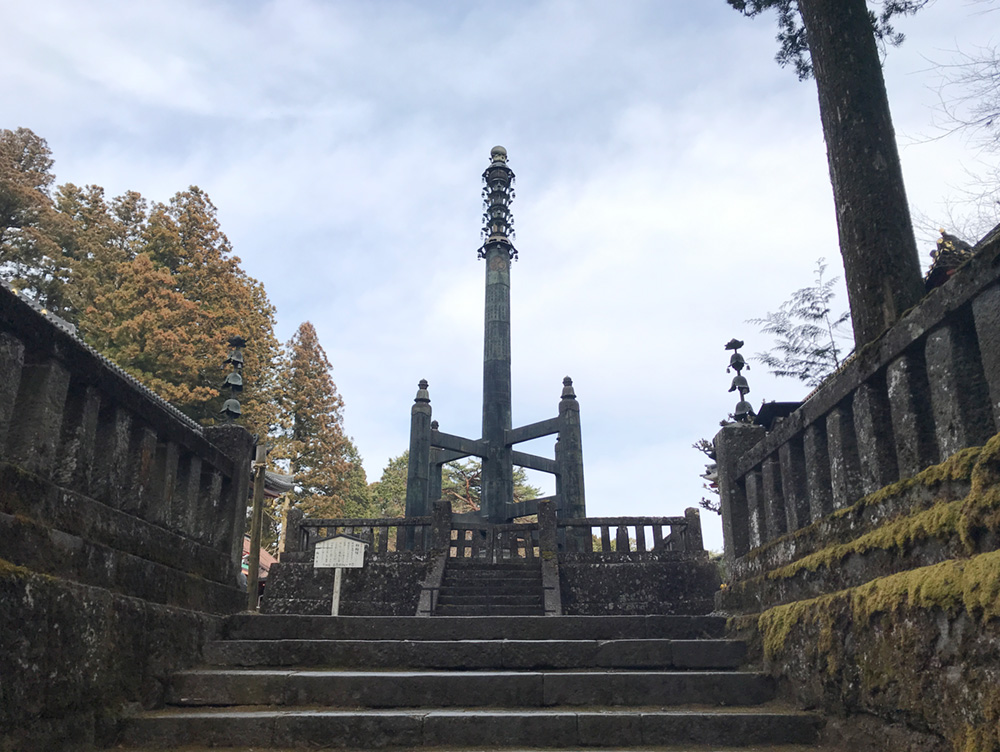相輪橖
Sorinto, Buddhist stupa
相轮樘
相輪樘
소린토, 사리탑
Sōrintō, stūpa bouddhiste
Sorinto, buddhistischer Stupa
Sorinto, estupa budista
โซรินโต (Sorinto) - พุทธเจดีย์

高さ16メートルの仏塔です。寛永20年(1643)、徳川三代将軍家光公の発願により、日光山第53世「天海大僧正」が世界の平和と繁栄を願って、東照宮の奥院鬼門に建立しましたが、その後の大地震のために新宮(現 二荒山神社)境内に移築され、さらに神仏分離によって明治14年(1881)に現在地に移されました。内部にはお釈迦様の舎利(遺骨)に見立てた「お経」が納められています。
正面左右にある燈籠は、山内最大の青銅製燈籠で「糸割符燈籠」とよばれます。家康公から生糸輸入の特権を許された京都、堺、江戸、大阪、長崎の糸割符商人が奉納したもので、胴体部分のレリーフは、中国の「二十四孝の物語」がモチーフとなっています。
This tower is in the form of the finial typically found on the roof of a pagoda. It was constructed by the monk Tenkai (1536–1643), the chief priest of the Nikko-zan temple complex in the early 1600’s when the Toshogu Shrine was built. The Sorinto houses a collection of Buddhist sutras and has great religious significance. The nine rings represent the five Wisdom Nyorai Buddhas and the four Bodhisattvas.
The design for this monument was inspired by Saicho (767–822), the founder of the Japanese Tendai sect of Buddhism. He had six such finials built across the country to provide Japan with the divine protection of the Buddhist Law. Tenkai built this finial to protect eastern Japan, to ward off evil spirits, and to maintain peace within the realm.
塔顶采用了佛塔塔顶经典的装饰头。17世纪初期东照宫始建时,日光山寺庙建筑群的住持僧人天海(1536-1643)所建。相轮樘藏有大量佛经,具有重大的宗教意义。9个环代表着五智如来和四位菩萨。
这座纪念碑的设计灵感来自日本佛教天台宗的创始人最澄(767–822)。他在全日本建造了6座相同的装饰头建筑,意在向日本提供佛法的神圣保护。天海修建这座宝塔是为了保护东日本,以除邪去害护佑天下太平。
塔頂採用了佛塔塔頂經典的裝飾頭。17世紀初期東照宮始建時,日光山寺廟建築群的住持僧人天海(1536-1643)所建。相輪樘藏有大量佛經,具有重大的宗教意義。9個環代表著五智如來和四位菩薩。
這座紀念碑的設計靈感來自日本佛教天臺宗的創始人最澄(767–822)。他在全日本建造了6座相同的裝飾頭建築,意在向日本提供佛法的神聖保護。天海修建這座寶塔是為了保護東日本,以除邪去害護佑天下太平。
탑의 지붕에서 일반적으로 볼 수 있는 장식 형태입니다. 도쇼구 신사가 지어진 1600년대 초반에 닛코잔 사찰 단지의 주지였던 덴카이(1536-1643)가 세웠습니다. 소린토에는 사리가 들어 있으며, 종교적 의미가 매우 큽니다. 9개의 고리는 오지여래와 사보살을 나타냅니다
탑의 디자인은 일본 천태종의 창시자인 사이초(767–822)로부터 영감을 받았습니다. 그는 일본이 불법의 신성한 보호를 받을 수 있도록 전국에 6개의 사리탑을 세웠습니다. 덴카이는 동일본을 보호하고, 악령을 물리치고, 나라의 평화를 유지하기 위해 소린토를 세웠습니다.
Cette tour a la forme du fleuron que l'on trouve généralement sur le toit d’une pagode. Il fut construit par le moine Tenkai (1536 - 1643), le prêtre en chef du complexe du temple de Nikkō-zan au début des années 1600, lorsque le sanctuaire de Tōshō-gū fut construit. Le Sōrintō abrite une collection de sūtras bouddhistes et a une grande signification religieuse. Les neuf anneaux représentent les cinq bouddhas de la sagesse Nyorai et les quatre bodhisattvas.
La conception de ce monument fut inspirée par Saichō (767 - 822), le fondateur de la secte bouddhiste japonaise Tendai. Il fit construire six de ces fleurons à travers le pays pour fournir au Japon la protection divine de la loi bouddhiste. Tenkai construisit ce fleuron pour protéger l'est du Japon, éloigner les mauvais esprits et maintenir la paix dans le royaume.
Dieser Turm hat die Form eines Monuments, das sich typischerweise auf dem Dach einer Pagode befindet. Er wurde vom Mönch Tenkai (1536–1643) erbaut, dem Hauptpriester der Nikkozan-Tempelanlage im frühen 17. Jahrhundert, als der Toshogu-Schrein errichtet wurde. Das Sorinto beherbergt eine Sammlung buddhistischer Sutras und hat eine große religiöse Bedeutung. Die neun Ringe repräsentieren die fünf Nyorai-Buddhas für Weisheit und die vier Bodhisattvas.
Beim Design dieses Denkmals ließ sich Tenkai von Saicho (767–822), dem Gründer des japanischen Tendai-Buddhismus, inspirieren. Er ließ sechs solcher Monumente im ganzen Land errichten, um Japan den göttlichen Schutz des buddhistischen Gesetzes zu gewähren. Tenkai baute dieses Monument, um Ostjapan zu schützen, böse Geister abzuwehren und den Frieden im Land zu wahren.
Esta torre presenta la forma del pináculo que suele tener el techo de una pagoda. Fue construida por el monje Tenkai (1536-1643), que era el sacerdote principal del complejo del templo Nikko-zan a principios del siglo XVII, cuando se erigió el santuario Toshogu. El Sorinto alberga una colección de sutras budistas y tiene una gran importancia religiosa. Los nueve anillos representan los cinco Budas Nyorai de la Sabiduría y los cuatro bodhisattvas.
El diseño de este monumento se inspiró en Saicho (767–822), el fundador de la secta Tendai del budismo japonés. Saicho hizo construir seis de esos pináculos en todo el país para brindar a Japón la protección divina de la Ley Budista. Tenkai construyó este pináculo para proteger el este de Japón, alejar a los espíritus malignos y mantener la paz dentro del dominio.
หอคอยนี้อยู่ในรูปแบบเครื่องยอด ซึ่งโดยทั่วไปจะพบในส่วนหลังคาของเจดีย์ ถูกสร้างขึ้นโดยพระเท็นไก (Tenkai) (ค.ศ. 1536-1643) หัวหน้านักบวชของกลุ่มวัดนิกโกซังในช่วงต้นศตวรรษที่ 17 เมื่อคราวที่ศาลเจ้าโทโชกุ (Toshogu) ถูกสร้างขึ้น โซรินโต (Sorinto) เป็นสถานที่เก็บรักษาพระสูตรทางพระพุทธศาสนาและมีความสำคัญทางศาสนาอย่างมาก วงแหวนทั้งเก้าแสดงถึงพระพุทธเจ้าผู้เลิศด้วยปัญญาทั้งห้าพระองค์และพระโพธิสัตว์ทั้งสี่พระองค์
การออกแบบอนุสาวรีย์แห่งนี้ ได้รับแรงบันดาลใจจากท่านไซโจ (Saicho) (ค.ศ. 767- 822) ผู้ก่อตั้งพระพุทธศาสนานิกายเท็นไดของญี่ปุ่น ท่านได้สร้างเครื่องยอดดังกล่าวไว้หกแห่งทั่วประเทศเพื่อให้ญี่ปุ่นมีการปกป้องคุ้มครองอันศักดิ์สิทธิ์แห่งพุทธบัญญัติ ท่านเท็นไกได้สร้างเครื่องยอดนี้ขึ้นเพื่อปกป้องญี่ปุ่นตะวันออก เพื่อขับไล่วิญญาณชั่วร้าย และเพื่อปกปักรักษาความสงบสุขภายในอาณาจักร
